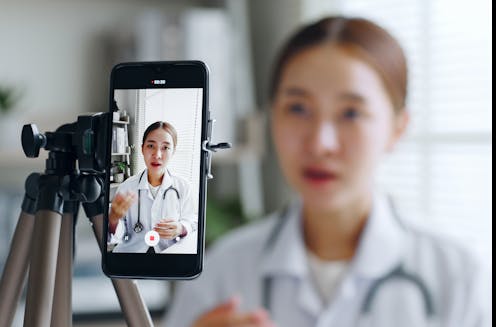
The social media platform TikTok has become a cultural phenomenon, influencing the behaviour and taste of its users in almost every area of life. From dance trends to skincare and make-up products, health hacks to fad diets, TikTok recommendations can go viral within minutes – and so can its health advice.
Some of the most searched educational videos on TikTok are on diet, exercise and sexual health.
“Fitspiration” is a popular social media hashtag aimed at motivating users to lead healthier lifestyles. “Fitspo” posts often include before and after images and or “aspirational” of photos of influencers with ideal body types. But numerous studies have found that many of these social media posts [can have a negative impact] on users’ mental health and promote or compound their body insecurities.
Social media has its upsides. For example it allows users to share their experiences of health issues. One study showed that 80% of cancer patients use social media to engage peers. But it can also help spread health misinformation.
For example, a 2023 survey conducted by Dublin City University found that 57% of Gen-Z and Millennial TikTok users are influenced by, or regularly adopt, nutrition trends from the platform. The same research also found that only 2.1% of the analysed nutrition content on TikTok proved to be accurate when compared to public health guidelines.
But this could be about to change. The World Health Organization (WHO) has announced a year-long partnership with TikTok to provide users with reliable, science-based evidence.
Healthcare professionals are already trying to raise levels of health literacy on social media, however. Doctors and specialists are publishing videos to educate users about melanoma and dark skin, for instance. These resources are much needed because, although melanoma is rarer in people with dark skin tones, the five-year survival rate is only 66%, compared to 90% in non-Hispanic whites. This is because melanoma is often diagnosed much later in people with darker skin.
Other cancer topics, such as laryngeal cancer, stomach cancer, thyroid cancer and breast cancer also show increased interaction from users. But while there are plenty of patient perspectives, there are far fewer and lower-quality resources from healthcare professionals.
A 2022 study found that of the most popular articles posted on social media in 2018 and 2019, on the four most common cancers, one in every three contained false, inaccurate or misleading information. And most of that misinformation about cancer was potentially harmful. For example, by promoting unproven treatments.
Stories shared by patients writing on social media about their cancer journeys can be powerful, particularly for users going through similar experiences. But they can also be scary – and are occasionally untrue.
Difficult subjects
Content about potentially embarrassing or intimate health issues have become popular on social media, which is often the first port of call when experiencing symptoms or after initial diagnosis.
Videos about anal fissures have attracted a significant number of views, while posts sharing experiences of intrauterine contraceptive devices have highlighted common side-effects that can help inform the contraceptive decisions of other users.
IVF is a valuable and growing discussion topic on social media, but more engagement is needed from experts to ensure the medical accuracy of advice and guidance.
Creating a force for good
Similarly, social media information on neurodevelopmental conditions, such as autism and ADHD, have seen a huge increase in viewer traffic. Celebrities, in particular, have used social media platforms to talk about their own diagnoses and urge or inspire others to seek help. For example, Tom Stoltman, the current reigning and three times World’s Strongest Man, has spoken openly about his autism diagnosis and how it can be a superpower.
The growing challenges around mental health diagnoses are a double-edged sword on social media. The availability of information can help understanding of conditions – but it can also fuel self-diagnoses, which are increasing and can cause strain on healthcare systems and potential harm to patients.
Various studies highlight the issue of health misinformation on social media. One study showed that X (formerly Twitter) had the highest level of misinformation. Many of the studies assessing social media health content show that less than 30% is medically accurate.
So, while social media health posts can be beneficial for those looking for patient perspectives, it’s important that users are also able to access high-quality, medically accurate resources from qualified professionals.
Hopefully, the WHO and TikTok collaboration will help to facilitate and promote more engagement from healthcare professionals on social media.
Adam Taylor does not work for, consult, own shares in or receive funding from any company or organisation that would benefit from this article, and has disclosed no relevant affiliations beyond their academic appointment.
This article was originally published on The Conversation. Read the original article.







